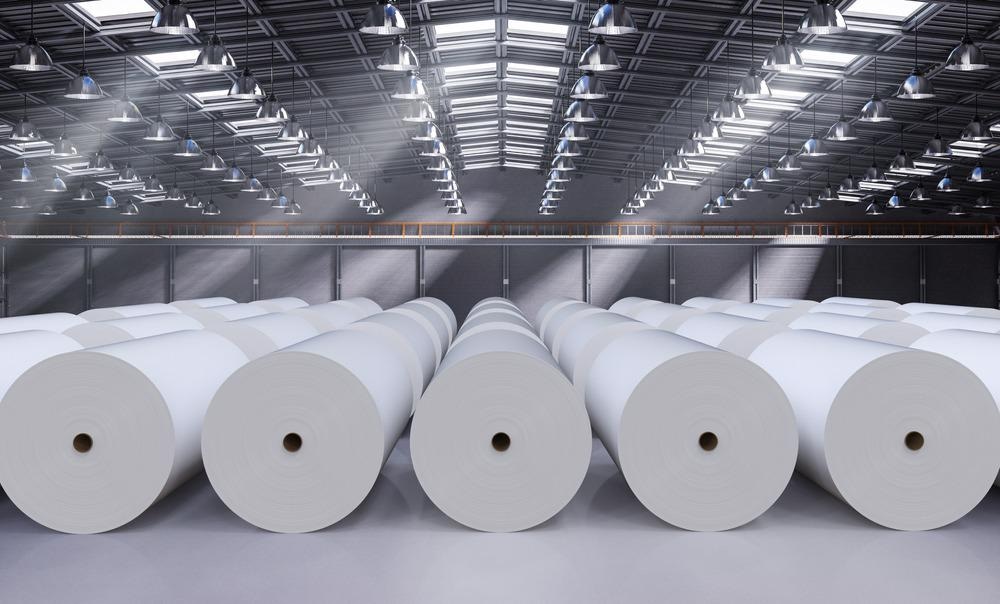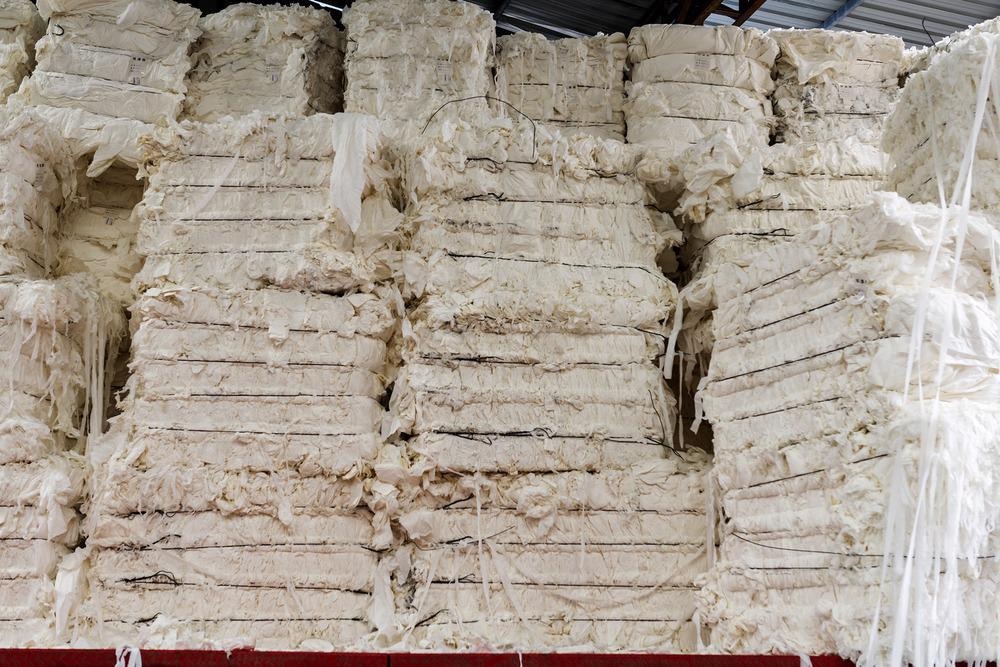The pulp paper industry is causing large-scale pollution affecting aquatic systems and the organisms within them due to the emission of organic and inorganic pollutants. Despite known adverse effects, few solutions are addressing existing issues.

Paper rolls in a factory. Image Credit: Phonlamai Photo/Shutterstock.com
The Detrimental Effects of the Pulp-paper Industry
Despite the rise of digital technology paper products remain in high demand, with 422 million metric tons of paper used globally in 2018. Over recent years, paper has been mostly used for packaging to cater to the surge of online orders.
Paper consists of wood fibers. Rags, flax, cotton lanterns, and sugarcane residues are also used to press, dry, then treat paper sheets. Pulp is a by-product made during paper manufacturing. It is a fibrous material used to make paper and paper-based products and is made from cellulose fibers and other plant materials combined with synthetic materials.
Paper production is associated with a number of consequences. Paper production requires twice as much energy to produce than a plastic bag, relies on deforestation, and causes extensive pollution. For instance, the pulp paper industry is responsible for releasing harmful volatile compounds including sulfur compounds and nitrogen oxides, as well as inorganic pollutants including ferrous, copper, zinc, nickel, and magnesium, throughout the papermaking process.
In addition, a considerable amount of paper is thrown away, with estimates indicating it may be equivalent to 11 billion trees annually in the US alone, resulting in paper making up 26% of total waste at landfills.
As a result, the pulp-paper industry is considered highly toxic and ranks sixth among the most polluting industries in the world. This ranking also does not account for the use of water and plants or its contributions to pollution of the air, water, and soil, which is difficult to quantify.
Nevertheless, the industry continues to expand globally, particularly in countries such as Russia, China and Indonesia, targeting countries with low wages, limited regulations, and low environmental oversight.
Assessing the Environmental Toxicity of the Pulp-paper Industry
Researchers have attempted to quantify the environmental impacts caused by the pulp-paper industry. Specifically, research on the effects of the discharged wastewater, the release of atmospheric gases, and the use of resources is gradually revealing the negative impacts of the paper manufacturing process.
This was the focus of a review chapter by Sharma and Singh (2021). The authors describe how the physicochemical properties of the discharge caused by the pulp–paper industry are unregulated and hazardous, with no sustainable solutions to address such issues.
Authors describe how in India alone, the pulp–paper manufacturers produce 400 tonnes per day of paper, with large-scale contamination resulting from the toxic sludge containing residual organic pollutants along with heavy metals. This contamination primarily occurs from the discharge during bleaching and pulping of paper, with the contaminants being passed from the environment into plants, animals, aquatic organisms, and eventually to people.
Toxicants are trophically-transmitted to humans through the consumption of animals or environmental exposure, and the authors of the study describe the severity of the waste generated from the pulp and paper industry and potential management for environmental safety.
Despite the high levels of toxicity documented in the discharged sludge during manufacturing, with reports of androgenic and mutagenic compounds, no technology for detoxification or degradation of these pollutants has been developed.
This has particularly extensive consequences for the aquatic environment due to the long-lasting, far-reaching, and transmissible potential of toxic chemicals to disrupt natural systems and impact human health.
The Consequences on Aquatic Environments and the Organisms Within Them
Toxic discharge from pulp paper production frequently outflows into riverine systems leading to the sea and ocean. The most important outcomes of this pollution are the effects on aquatic organisms, which were reviewed in 2019 by Singh and Chandra, 2019.
The authors describe the impacts associated with pulp paper pollution across trophic levels. Specifically, how the major inorganic pollutants, including ferrous, copper, zinc, nickel, and magnesium, are able to bioaccumulate across the food chain. These are particularly harmful toxicants, with reports of causing extensive damage due to high levels of neurotoxicity in species such as catfish (Ictalurus punctatus).
Other pollutants produced by the pulp paper industry include hexadecanoic acids, trichlorocatechol, tetrachlorocatechol, chlorophenols, terpenes, methanol, phenol, alkylated phenols, decalone, benzoic acid, abietic acid, and dehydroabietic acid. These compounds are known endocrine-disrupting chemicals (EDCs) with direct effects on the reproductive system in aquatic flora and fauna.
Impacts include reduced gonad size, changes in secondary sexual characters, delayed maturity and suppression of sex hormone in fish rainbow trout (Oncorhynchus mykiss) and mosquitofish (Gambusia holbrooki).
Other impacts from exposure to such toxicants are recognized from in vitro studies, including effects on Salmonella typhimurium, Vibrio fischeri, and Saccharomyces, which experience inhibited growth and reduced luminescence properties. Further adverse effects have also been recorded on water chemistry, as pollutants are able to affect the physicochemical properties of fresh and saltwater systems. In turn, this exacerbates impacts on organisms due to an increase in algal blooms and deterioration of physiological processes, ultimately resulting in the decline of populations.
Authors, therefore, highlight the effects of pollutants across trophic levels, from bacteria to fish, as well as the effects on overall water chemistry. This has harmful effects on human health since aquatic organisms are a key source of nutritional content for many communities and consumption of polluted organisms leads to adverse effects for humans.

Paper and pulp mill. Image Credit: hxdyl/Shutterstock.com
Treating Pulp-paper Toxicity and Future Implications
Despite longstanding evidence of the toxicity of pulp paper emissions into aquatic and other environmental systems, no sustainable solutions have been developed to address chemicals leeching from manufacturing plants or to absorb existing elements already polluting systems.
Recent innovations over the past year to mitigate some of the organic and inorganic pollutants using biological agents of remediation include the use of Bacillus cereus AKRC03, an isolated bacterial strain, which was capable of degrading nearly 80% of organic pollutants. Further research using Tubifex tubifex worms showed they were also able to reduce toxicity by 70% in treated wastewater.
Using biological agents to treat wastewater provides a promising solution for detoxification and degradation of discharged pulp paper mill wastewater for environmental safety. However, issues remain particularly for aquatic systems as waste can be transported across large spatial scales due to water currents, and solutions remain to be developed to treat polluted areas.
In an increasingly digital world, technological innovations should reduce our reliance on paper products with the aim of paperless manufacturing. However, this is likely to increase our dependency on plastic materials to replace paper products. Therefore, in order to improve current paper production practices, solutions are required to reduce the dependency on toxic materials during paper manufacturing processes, treat wastewater before entering natural systems, and treat systems that are already polluted.
Sources:
- Kumar, A., & Chandra, R. (2021). Biodegradation and toxicity reduction of pulp paper mill wastewater by isolated laccase producing Bacillus cereus AKRC03. Cleaner Engineering and Technology, 4, 100193. https://doi.org/10.1016/j.clet.2021.100193
- Sharma, P., & Singh, S. P. (2021). Pollutants Characterization and Toxicity Assessment of Pulp and Paper Industry Sludge for Safe Environmental Disposal. Emerging Treatment Technologies for Waste Management, 207–223. https://doi.org/10.1007/978-981-16-2015-7_10
- Singh, A. K., & Chandra, R. (2019a). Pollutants released from the pulp paper industry: Aquatic toxicity and their health hazards. Aquatic Toxicology, 211, 202–216. https://doi.org/10.1016/j.aquatox.2019.04.007
- Singh, A. K., & Chandra, R. (2019b). Pollutants released from the pulp paper industry: Aquatic toxicity and their health hazards. Aquatic Toxicology, 211, 202–216. https://doi.org/10.1016/j.aquatox.2019.04.007
Further Reading